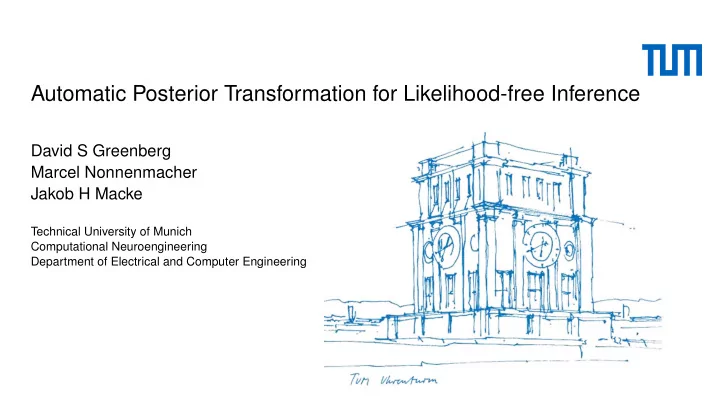

Automatic Posterior Transformation for Likelihood-free Inference David S Greenberg Marcel Nonnenmacher Jakob H Macke Technical University of Munich Computational Neuroengineering Department of Electrical and Computer Engineering
For many important simulators, the likelihood is unavailable Climate Cell biology Mycoplasma Genitalium , Karr et al., 2016 Neuroscience Cosmology Homarus Americanus , Prinz et al., 2004
Bayesian Inference without Likelihood Evaluation Given a simulator, a prior on its parameters, forward model and observed data, we aim to infer the posterior distribution on parameters. We cannot evaluate the likelihood prior over parameters posterior p ( data | parameters ) =??? But we can sample data given parameters measured data simulation ∼ p ( data | parameters )
Sequential Neural Posterior Estimation (SNPE) forward model prior simulated data posterior measured data density estimator … … …
Automatic Posterior Transformation vs. previous methods Number of simulations 1000 5000 10000 SNPE-A Papamakarios & Murray, 2016 Restricts choice of proposal and density estimator, can't reuse data True posterior SNPE-B Lueckmann et al., 2017 Importance weights limit performance SNL Papamakarios et al., 2017 Estimates likelihood instead of posterior, requires MCMC after training 1000 100K 500M Classical ABC Requires many more simulations Automatic Posterior Transformation Posterior estimation with fl ows or MDNs Simulation parameters can be freely chosen Feature learning (no summary stats) Scales to high dimesional data (10000+)
predators population count 200 Lotka-Volterra model prey Lotka, 1920 100 0 0 50 100 150 time steps − log p ( true parameters ) , lower is better Posterior SNPE-A SNPE-B SNL APT (ours) 5 0 -5 Number of 10 3 10 4 θ 1 θ 2 θ 3 θ 4 simulations (log scale)
Rock-Paper-Scissors model Reichenbach et al., 2008 Simulator is defined by a stochastic PDE. Data is 10000 dimensional. CNN-based feature learning. APT infers tight posteriors around the -log p(true parameters) ground-truth parameters. APT (ours)
Thanks! More details at poster 238, tonight at 6:30pm in the Pacific Ballroom . Marcel Nonnenmacher Jakob Macke Funded by the German Research Foundation (DFG) through SFB 1233 (276693517), SFB 1089 and SPP 2041 and the German Federal Ministry of Education and Research (BMBF , project ‘ADMIMEM,’ FKZ 01IS18052 A-D).
Recommend
More recommend